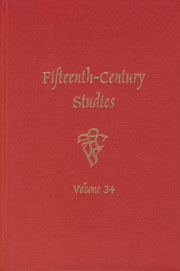Book contents
- Frontmatter
- Contents
- Essays
- 1 The Current State of Research on Late-Medieval Drama. 2007–2008: Survey, Bibliography, and Reviews
- 2 Poetry as Source for Illustrated Prose: The 1519 Strassburg Wigoleis vom Rade
- 3 The St. Edith Cycle in The Salisbury Breviary (c.1460)
- 4 L'épanouissement de l'histoire au quinzième siècle en France
- 5 Escuelas de traducción en la Edad Media
- 6 Ten Poems from the Gruuthuse Songbook (c.1462)
- 7 Louis XI, A French Monarch in Pilgrim's Garb: Badges
- 8 Robert Henryson's Morall Fabilles: Irony, Allegory, and Humanism in Late-Medieval Fables
- 9 Defining Violence in Middle English Romances: Sir Gowther and Libeaus Desconus
- 10 Presencia y Ausencia de los Judíos en los Sermons de quaresma de Vicente Ferrer
- 11 “Als ich dich vor gelert haun”: Conrad Buitzruss's Recipe Collection in Manuscript Clm 671 (Munich)
- 12 Book Reviews
2 - Poetry as Source for Illustrated Prose: The 1519 Strassburg Wigoleis vom Rade
from Essays
Published online by Cambridge University Press: 05 September 2013
- Frontmatter
- Contents
- Essays
- 1 The Current State of Research on Late-Medieval Drama. 2007–2008: Survey, Bibliography, and Reviews
- 2 Poetry as Source for Illustrated Prose: The 1519 Strassburg Wigoleis vom Rade
- 3 The St. Edith Cycle in The Salisbury Breviary (c.1460)
- 4 L'épanouissement de l'histoire au quinzième siècle en France
- 5 Escuelas de traducción en la Edad Media
- 6 Ten Poems from the Gruuthuse Songbook (c.1462)
- 7 Louis XI, A French Monarch in Pilgrim's Garb: Badges
- 8 Robert Henryson's Morall Fabilles: Irony, Allegory, and Humanism in Late-Medieval Fables
- 9 Defining Violence in Middle English Romances: Sir Gowther and Libeaus Desconus
- 10 Presencia y Ausencia de los Judíos en los Sermons de quaresma de Vicente Ferrer
- 11 “Als ich dich vor gelert haun”: Conrad Buitzruss's Recipe Collection in Manuscript Clm 671 (Munich)
- 12 Book Reviews
Summary
Wirnt von Grafenberg (fl. 1204–10) wrote Wigalois, an Arthurian verse romance which alludes to characters from Erec, Iwein, both by Hartmann von Aue (c.1160–after 1210), and Parzival by Wolfram von Eschenbach (first half of thirteenth century). Hartmann's and Wolfram's stories were of course well known ever since Chrétien de Troyes created the source tales (twelfth century). Grafenberg's Wigalois itself consisted of 11708 verses in rhymed couplets. The hero Gwigalois is Gawein's son, whose life is told in five parts: the hero's upbringing in his mother's fairy kingdom; his arrival at Arthur's court and his adventures in the Arthurian realm; his experiences in the otherworldly realm of Korntin and ultimate triumph over the prince of darkness, the heathen King Roaz of Glois; the hero's wedding and coronation; and the avenging of a wedding guest's murder. Literary critics have tended to deem Gwigalois an “unproblematic knight of Fortune's wheel”; more recent studies have seen him as a flawed character in need of God's mercy. The romance enjoyed surprising popularity and was the source for a number of fifteenth- and sixteenth-c. chapbooks with woodcuts, called Wigoleis vom Rade.
One of the first aspects which modern readers of Wirnt von Grafenberg's thirteenth-c. courtly romance Wigalois notice about the text is the extraordinary number of descriptions: throughout the tale, shields, wondrous objects, castles, and buildings, clothing, and weapons are all described in the most intimate detail. Such sections are known as ekphrasis, one of the important and commonly used rhetorical devices in ancient and medieval literature.
- Type
- Chapter
- Information
- Fifteenth-Century Studies , pp. 24 - 47Publisher: Boydell & BrewerPrint publication year: 2009



